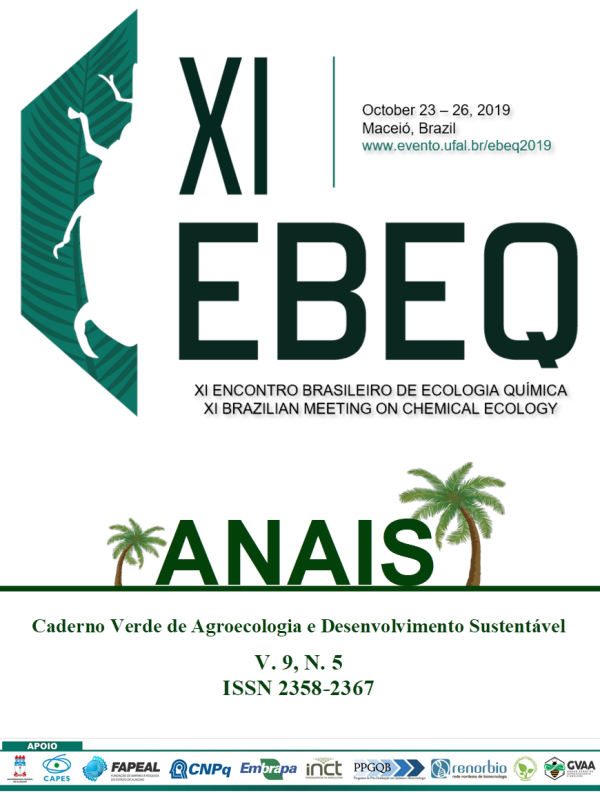COMPOSTOS ORGÂNICOS VOLÁTEIS PRODUZIDOS POR FUNGOS ENTOMOPATOGÊNICOS ISOLADOS DE Rhynchophorus palmarum (LINNAEUS 1764) (COLEOPTERA: CURCULIONIDAE)
Palavras-chave:
VOCS, ARECÁCEAE, SEMIOQUÍMICOS, FUNGOS ENTOMOPATOGENICOS NATIVOS.Resumo
Rhynchophorus palmarum (Linnaeus, 1764), conhecido como broca do coqueiro da América do Sul, pertence à ordem Coleoptera, da família Curculionidae, se alimentam e ovipositam em plantas da família Arecáceae, seus hospedeiros habituais. Este inseto é uma praga nas plantações de coco (Cocos nucifera) e dendezeiros (Elaeis guinensis). As atuais estratégias para o controle R. palmarum incluem práticas culturais, mecânicas, comportamentais e biológicas. Com o objetivo de analisar os compostos orgânicos voláteis (COVs) emitidos por fungos entomopatogênicos nativos que parasitam naturalmente R. palmarum insetos adultos foram capturados com armadilhas contendo rincoforol® (feromônio de agregação), em fazendas localizadas no município de Coruripe, Alagoas, Brasil. Foram coletados 814 insetos,e destes, utilizaram-se 50 fêmeas e 50 machos, que incubados a 25±1° C e fotoperíodo de 12 horas, para analisar a mortalidade e crescimento fúngico. Após 20 dias de incubação, 10 insetos apresentaram crescimento fúngico. Os fragmentos retirados dos corpos de frutificação foram cultivados em placa de Petri em meio B.D.A. (Batata Dextrose Agar), e incubados a 25”C para purificação dos isolados. Após 14 dias, os isolados foram separados em 2 grupos, diferenciados de acordo com as características morfológicas apresentadas, denominados grupos 1 e 2. As amostras dos fungos entomopatogênicos nativos foram inoculados em vials âmbar e incubados por 7 dias. Os COVs foram extraídos por exposição de 2 horas, a 60°C em placa termostática, pela técnica de Micro Extração em Fase Sólida (HS-SPME). Após essa etapa para caracterização de metabolitos voláteis utilizou-se a técnica Cromatografia á Gás acoplada ao Espectrometria de Massas (GC-MS) para identificação dos compostos. Os compostos orgânicos caracterizados pertencem aos grupos dos hidrocarbonetos, álcoois, aldeídos, cetonas, ésteres, monoterpenos e sesquiterpenos.Referências
Adams, R.P. (2007) Identification of Essential Oil Components by Gas Chromatography/Mass Spectrometry. Caron Stream, IL: Allered Publishing Corporation.
Alston, D.G., 2011. General Concepts of Biological Control. Utah Pests Fact Sheet IPM015-11, pp. 1–2. Augustyniuk-Kram, A., 2010. Organizmy pożyteczne w strategiach biologicznego zwalczania - grzyby owadobójcze. Stud. Ecol. Bioethicae 8 (1), 45–54.
Bashan, M., 1998. The distribuition in lipid classes of fatty acids biosynthesized by the black cricket Melanogryllus desertus Pall. (Orthoptera: Gryllidae). Turkish J. Entomol. 22, 93–99.
Ben Hammouda, I., Freitas, F., Ammar, S., Gomes Da Silva, M.D.R., Bouaziz, M., 2017.
Comparison and characterization of volatile compounds as markers of oils stability during frying by HS–SPME-GC/MS and chemometric analysis. J. Chromatogr. B Anal. Technol. Biomed. Life Sci. 1068–1069, 322–334.
Dalbon, V. A.; Acevedo, J.P.M; Santana, A.E.G.; Goulart, H.F.
Laterza, I.; Riffel, A.; Negrisoli Jr, A.; Bohr, B.; Porcelli, F.Early detection and preventive control of Rhynchophorus ferrugineus (Coleoptera Curculionidae): a quarantine pest in Brazil. Arab Journal for Plant Protection. 2019, V(37) 2: 130-135.
Mnif, I., Ghribi, D., 2015. Potential of bacterial derived biopesticides in pest management. Crop Prot. 77, 52–64.
WANDERLEY. M.; LOPES, G. M. Importância sócio-econômica da produção de coco seco no Brasil. In: CINTRA, F. L. D.; FONTES, H. R.; PASSOS, E. E. M.; FERREIRA, J. M. S. (Ed.). Fundamentos tecnológicos para a revitalização das áreas cultivadas com coqueiro gigante no nordeste do Brasil. Aracaju: Embrapa Tabuleiros Costeiros, 2009. p. 37-60.
H. R.; PASSOS, E. E. M. et al. (Ed.). Fundamentos tecnológicos para a revitalização das áreas cultivadas com coqueiro gigante no Nordeste do Brasil. Aracaju: Embrapa Tabuleiros Costeiros, 2009. p. 157-190.
Downloads
Arquivos adicionais
Publicado
Como Citar
Edição
Seção
Licença
Termo de cessão de direitos autorias
Esta é uma revista de acesso livre, em que, utiliza o termo de cessão seguindo a lei nº 9.610/1998, que altera, atualiza e consolida a legislação sobre direitos autorais no Brasil.
O(s) autor(es) doravante designado(s) CEDENTE, por meio desta, publica a OBRA no Caderno Verde de Agroecologia e Desenvolvimento Sustentável, representada pelo Grupo Verde de Agroecologia e Abelhas (GVAA), estabelecida na Rua Vicente Alves da Silva, 101, Bairro Petrópolis, Cidade de Pombal, Paraíba, Brasil. Caixa Postal 54 CEP 58840-000 doravante designada CESSIONÁRIA, nas condições descritas a seguir:
O CEDENTE declara que é (são) autor(es) e titular(es) da propriedade dos direitos autorais da OBRA submetida.
O CEDENTE declara que a OBRA não infringe direitos autorais e/ou outros direitos de propriedade de terceiros, que a divulgação de imagens (caso as mesmas existam) foi autorizada e que assume integral responsabilidade moral e/ou patrimonial, pelo seu conteúdo, perante terceiros.
O CEDENTE mantêm os direitos autorais e concedem à revista o direito de divulgação da OBRA, com o trabalho simultaneamente licenciado sob a Licença Creative Commons do tipo atribuição CC-BY.
O CEDENTE têm autorização para distribuição não-exclusiva da versão do trabalho publicada nesta revista.
O CEDENTE têm permissão e são estimulados a publicar e distribuir seu trabalho online (ex.: em repositórios institucionais ou na sua página pessoal) a qualquer ponto antes ou durante o processo editorial, já que isso pode gerar alterações produtivas, bem como aumentar o impacto e a citação do trabalho publicado.








